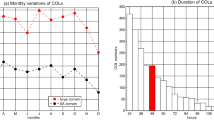Abstract
The existence of cut-off lows (COLs) over South Pacific and South America is often associated with adverse weather events such as intense precipitation over the central region of South America, frost episodes in southern Brazil and the development of Andes lee cyclones and intense cyclones over the southern coast of Brazil. Despite this importance, the formation and maintenance mechanisms of the COLs are not well understood. To detail the significant variability in terms of the eddy kinetic energy equation for fifty cases of COLs that formed over the southeastern Pacific Ocean is the aim of this study. Only the cases of COLs that formed over the ocean and remained there during most of their life were chosen. The main terms of the equation [ageostrophic flux convergence (AFC), baroclinic conversion (BRC) and barotropic conversion (BRT)] were calculated using the 6-hourly gridded data from the National Centers for Environmental Prediction/Department of Energy reanalysis. The formation mechanism of the COLs was associated with BRC and AFC. During the midlife period, the BRC term converted eddy kinetic energy to eddy potential energy and the AFC had a positive contribution until 6 h after the midlife point. In the dissipation phase, the BRC term remained positive and AFC became negative. The BRT extracted kinetic energy from the COL during the entire life cycle. The AFC term was the most important in all phases of the cut-off lifetime, and it was the responsible for extending the cut-off lifetime while the others terms were negatives.






Similar content being viewed by others
References
Berbery EH, Vera CS (1996) Characteristics of the Southern Hemisphere winter storm tracks with filtered and unfiltered data. J Atmos Sci 53:468–481
Campetella CM, Possia NE (2007) Upper-level cut-off lows in southern South America. Meteorol Atmos Phys 96(1–2):181–191
Chang EKM (2000) Wave packets and life cycles of troughs in the upper troposphere: examples from the Southern Hemisphere summer season of 1984/85. Mon Weather Rev 128:25–50
Chen H (2015) Downstream development of baroclinic waves in the midlatitude jet induced by extratropical transition: a case study. Adv Atmos Sci 32(4):528–540
Danielson RE, Gyakum JR, Straub DN (2006) A case study of downstream baroclinic development over the North Pacific Ocean. Part II: diagnoses of eddy energy and wave activity. Mon Weather Rev 134:1549–1567
Decker SG, Martin JE (2005) A local energetics analysis of the life cycle differences between consecutive, explosively deepening, continental cyclones. Mon Weather Rev 133:295–316
Fortune MA, Kousky VE (1983) Two severe freezes in Brazil: precursors and synoptic evolution. Mon Weather Rev 111:181–196
Fuenzalida HA, Sánchez R, Garreaud R (2005) A climatology of cutoff lows in the Southern Hemisphere. J Geophys Res 110:D18101. doi:10.1029/2005JD005934
Gan MA, Piva ED (2013) Energetics of a southearstern Pacific cut-off low. Atmos Sci Let 14:272–280. doi:10.1002/asl2.451
Gan MA, Rao VB (1996) Case studies of cyclogenesis over South America. Meteorol Appl 3:359–369
Garreaud RD, Fuenzalida HA (2007) The influence of the Andes on cutoff lows: a modeling study. Mon Weather Rev 15:1596–1613
Hyndman RJ (1996) Computing and graphing highest density regions. Am Stat 50(2):120–126
Kanamitsu M, Ebisuzaki W, Woollen JS et al (2002) NCEP–DOE AMIP-II reanalysis (R-2). Bull Am Meteorol Soc 83:1631–1643
Kousky VE, Gan MA (1981) Upper tropospheric cyclonic vortices in the tropical South Atlantic. Tellus 33:538–551
McGill R, Tukey JW, Larsen WA (1978) Variations of box plots. Am Stat 32:12–16
Miky Funatsu B, Gan MA, Caetano Neto E (2004) A case study of orographic cyclogenesis over South America. Atmósfera 17:91–113
Nielsen-Gammon JW (1995) Dynamical conceptual models of upper-level mobile trough formation: comparison and application. Tellus 47A:705–721
Orlanski I, Katzfey J (1991) The life cycle of a cyclone wave in the Southern Hemisphere. 1. Eddy energy budget. J Atmos Sci 48:1972–1998
Orlanski I, Sheldon JP (1995) Stages in the energetics of baroclinic systems. Tellus 47A:605–628
Palmer CE (1951) On high-level cyclones originating in the tropics. Trans Am Geophys Union 32(5):683–695
Petterssen S, Smebye SJ (1971) On the development of extratropical cyclones. Q J Roy Meteorol Soc 97:457–482
Piva ED, Gan MA, Rao VB (2008) An objective study of 500-hPa moving troughs in the southern hemisphere. Mon Weather Rev 136:2186–2200
Piva ED, Gan MA, Rao VB (2010) Energetics of winter troughs entering South America. Mon Weather Rev 138(4):1084–1103
Pizarro J, Montecinos A (2000) Cutoff ciclones off the coast of Chile. In: Preprints sixth conference Southern Hemisphere meteorology and oceanography, pp 278–279
Randel WJ, Stanford JL (1985) The observed life cycle of a baroclinic instability. J Atmos Sci 42(13):1364–1373
Rao VB, Carmo AMCdo, Franchito SH (2002) Seasonal variations in the southern hemisphere storm tracks and associated wave propagation. J Atmos Sci 59:1029–1040
Reboita MS, Nieto R, Gimeno L et al (2010) Climatological features of cutoff low systems in the Southern Hemisphere. J Geophys Res 115:D17104. doi:10.1029/2009JD013251
Acknowledgments
This work was supported by the Conselho Nacional de Desenvolvimento Científico e Tecnológico (CNPq, Projects 490401/2006-6 and 302188/2007-0).
Author information
Authors and Affiliations
Corresponding author
Rights and permissions
About this article
Cite this article
Gan, M.A., Piva, E.D. Energetics of southeastern Pacific cut-off lows. Clim Dyn 46, 3453–3462 (2016). https://doi.org/10.1007/s00382-015-2779-7
Received:
Accepted:
Published:
Issue Date:
DOI: https://doi.org/10.1007/s00382-015-2779-7




